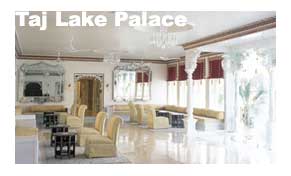|
 Leisure and fitness: Leisure and fitness:
You can spend your leisurely afternoons by the poolside. The pools is inviting for a swim in the cool waters. There is a mini gym where you can burnout extra calories of your body. The hotel organizes folk dances, puppet shows and traditional wooden boat rides on the Lake Pichola.
Around the City:
Udaipur is also known as the City of Sunrise. It was the capital of the erstwhile kingdom of Mewar, one of the oldest surviving dynasties in the world. The city was established around 1567 A.D. according to the legend, the Rajput rulers were the descendents of the Sun God. The Golden Sun, which represents the Sun God, is still the royal insignia of the Maharana of Mewar. There are several places to visit in Udaipur.
The City Palace, built in 1567 AD, stands on a hill on the banks of Lake Pichola. The entire palace complex comprises of 4 major palaces and several minor palaces. The main entrance is through a triple arched gate, the Tripolia, built in 1725 AD. The Rai Angaan or the Royal Courtyard has a shrine, the oldest part of Udaipur. It is at this very place that Udai Singh met an ascetic who suggested this site for the capital, Udaipur. The Mor Chowk or the Peacock Courtyard, built in the 17th century AD gets its name from inlaid glass mosaics of peacocks on its walls.
Overlooking the Grand Durbar Hall is the Crystal Gallery in Fateh Prakash Hotel. The gallery has a rare collection of Osler's crystal ordered from England by Maharana Sajjan Singh in 1877. there are crystal chandeliers and crystal furniture like a bed, chairs and dressing tables.
Maharana Jagat Singh I built the Jagdish temple in 1651 AD. The temple, dedicated to Lord Vishnu, has a stately 79 ft high pagoda decorated with the sculptures of dancers, musicians, elephants and horsemen. It is the largest and most magnificent temple.
The Sajjan Garh, located on top of a hill overlooking Lake Pichola, is also known as the Monsoon Palace. Maharana Sajjan Singh built the building to use it as an observatory in the late 19th century. It offers an alluring view of the city and the surrounding lakes, rivers and Aravali ranges. The wooded hillside surrounding it was once a royal hunting ground. The hillside leading up to Sajjan Garh is a wildlife sanctuary.
Lake Pichola is the famous lake of Udaipur. It is surrounded on all the sides by the hills, palaces, temples, bathing ghats and embankments. The Jag Niwas and Jag Mandir are the two island palaces situated over the lake.
Sahelion ki Bari is garden built by Maharana Sangram Singh for his daughter and the ladies of the Queen's court. He wanted to recreate the monsoon for his daughter, who had been ill for a long period. The garden has several fountains and four pools decorated with finely well-defined pavilions and elephants. The fountains still work on the unique hydraulic system devised in 1700 A.D
Ahar was originally the ancient capital of Mewar, till Chittor was founded in the 8th century AD. It was later used as the cremation ground for the Maharanas, following the establishment of Udaipur. It has 19 cenotaphs or 'chattris' made of white marble of the 19 rulers cremated here along with their queens. Ahar is also an ancient archaeological site. There is a small museum, which displays the relics dating back to 3000 years.
Maharana Fateh Singh built the Fateh Sagar Lake. Hills on three sides and a dam on the fourth side surround the lake. You can go on a boat ride to Nehru Park, an island garden.
Shilpgram Literally means the Craftsmen's Village. It is a living ethnographic museum, which presents the extensive diversities in the rural folk craft, art and culture in India. There are 26 huts set amid rustic surroundings representing the states of Maharashtra, Gujarat, Rajasthan, Goa and Daman. There are regular music and dance performances and camel rides. Authentic handicrafts of the region are also on sale.
| 

 Leisure and fitness:
Leisure and fitness:
